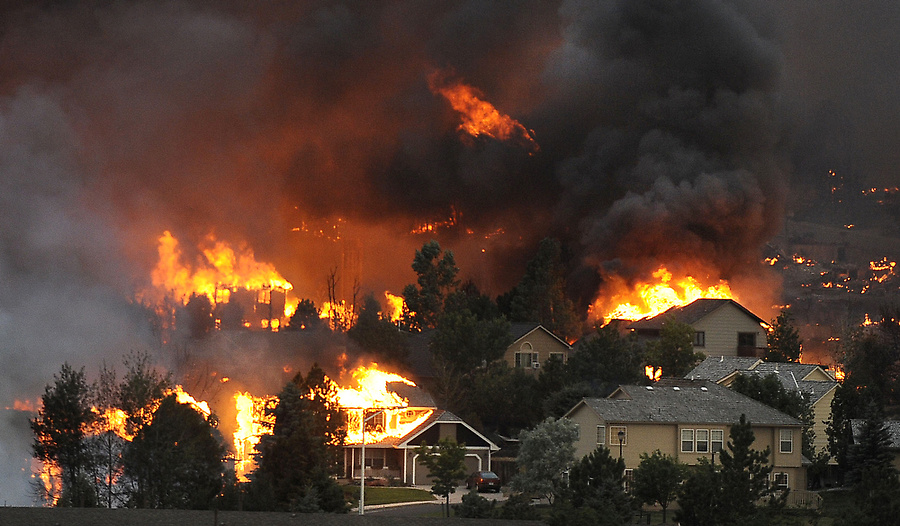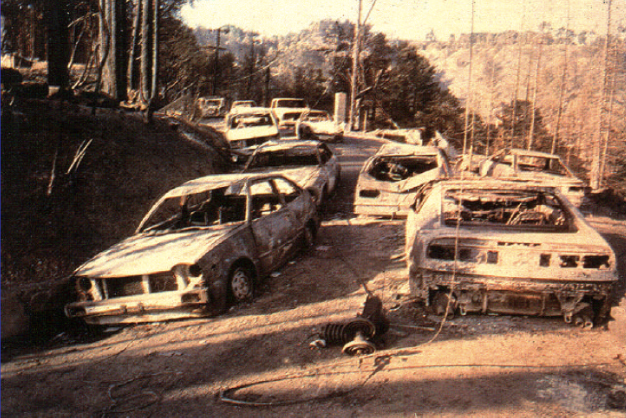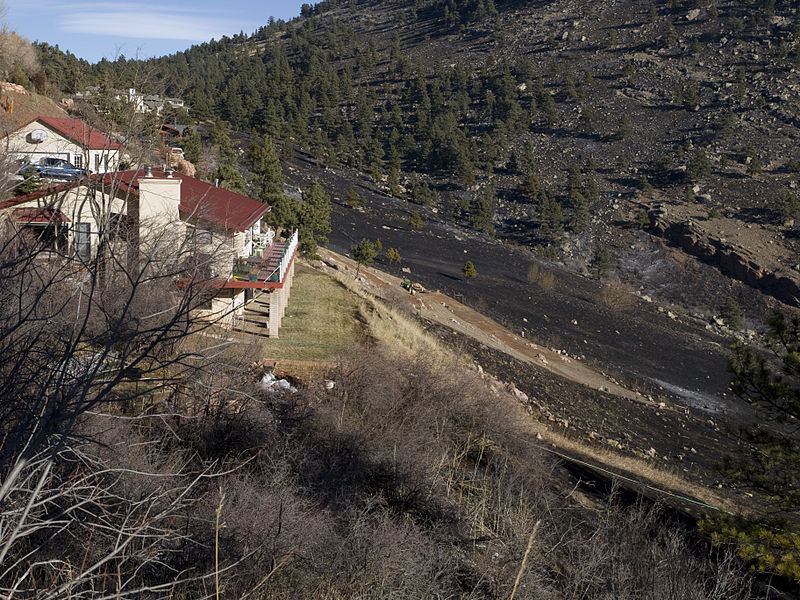
by Gordon S. Novak Jr.

Knowledgeable residents of West Lake Hills are well aware that we are at high risk of catastrophic wildfire (this picture is from Colorado Springs a few years ago). West Lake Hills has many similarities to Oakland Hills, California, where a firestorm in 1991 killed 25 residents, injured 150, and burned over 3,000 buildings in just a few hours.
West Lake Hills is already known to be at great risk; click on this Map and type in 78746, and look at how much of West Lake Hills is colored dark orange, the worst fire risk. West Lake Hills is rated at much higher risk than Bastrop was prior to its fires (it is easy to move the map down the road to Bastrop, which is colored light orange).
West Lake Hills has taken some actions for fire safety, but needs to do much more. This page details some additional actions and changes to ordinances that I think the City should make for fire safety. Also see Westlake Wildfire, Tom Keller's excellent site.
Fire hydrant systems are typically designed to allow the fire department to fight a single house or building fire. The needs for fighting wildfire are different: we need to engineer a hydrant system to support fighting a wildfire that may have a long fire front (up to a mile long), may last for several days, may involve sections of the city that have been burned, and may have considerable support of personnel and engines from surrounding areas.
Jack Cohen is a Research Physical Scientist for the Missoula Fire Sciences Laboratory in Montana; he is the world's leading expert on wildfire, the urban-wildland interface, and ways to prevent destruction of buildings and loss of life from wildfire. FEMA (Federal Emergency Management Agency) calls him "the Sherlock Holmes of wildfire". He is especially notable for having done many scientific experiments involving wildfire and building ignition, so that he knows how fire behaves and knows what fire prevention strategies work.
One such simulation program is Farsite.
The City should hire an appropriate expert, as recommended by Jack Cohen, to prepare and run simulations of wildfire in various conditions in West Lake Hills, in consultation with the fire department. We should also simulate various mitigation options such as shaded fuel breaks.

This image, from the Oakland Hills fire, shows cars that were unable to evacuate because of fire across the road. Some residents died as a result; elderly residents, in particular, were unable to run away when their cars became trapped by fire.
West Lake Hills has the same kind of topography, with narrow, curving roads and limited escape routes, that Oakland Hills has. We need to ensure the ability of residents to evacuate in case of fire.
The Fire Department has recommended that there be a 10-foot area on both sides of the street that is free of trees and vegetation (except for some notable tree specimens). West Lake Hills should definitely adopt this recommendation by our fire professionals.
In addition to the 10-foot recommendation of the fire department, the City should declare major roads in wooded areas to be Evacuation Corridors, and perform additional treatment to these roads. The Evacuation Corridors should include at least Westlake Drive, Redbud Trail, Terrace Mountain Drive, Yaupon Valley Road, and Laurel Valley Road. On Evacuation Corridors, trees should be trimmed up and surface deadwood should be removed for a distance of 30 feet from the pavement edge (50 feet in areas of high slope). The purpose of this trimming and fuel removal is to prevent fire from crossing these roads and preventing citizens from evacuating in the event of wildfire.

The photo above shows how Defensible Space allowed a house to survive a wildfire. Although West Lake Hills is recognized as a Firewise city, ironically the City prohibits tree removal to meet Firewise Defensible Space Recommendations.
It should be noted that West Lake Hills does not have a natural forest; we have an unnatural forest resulting from fifty years of fire suppression. In a natural central Texas forest, there are wildfires every few years, and these have the effect of eliminating small juniper trees. With fire suppression, the natural elimination of small junipers has been prevented, with the result that we have too many junipers. This is not good for other species nor for wildlife, since an area of dense junipers is a dead zone without grass, shrubbery, other trees, or wildlife. Removing some of our excess junipers should be seen as the restoration of the balance of a central Texas forest.
Firewise recommends a spacing of 10 feet between tree canopies (20 feet of separation on a slope) within 100 feet of a house. Such a separation prevents fire from jumping between tree canopies, and slows the spread of fire, giving residents time to escape the fire and giving the fire department more time to fight it.
Residents should be allowed to remove some juniper ("cedar") trees to meet Firewise standards within 100 feet of a house, and less stringent thinning within 200 feet of a house; these distances should be increased on slopes. This could be implemented by allowing residents to get a permit for tree removal from the City Arborist (who should be given appropriate training in Firewise standards if needed) or by allowing contractors who have Firewise training and certification and are registered with the City to perform the work.
Firewise standards do not mean clear-cutting, and would not change the look of the City. For one thing, the proposal allows thinning of junipers, but does not require it, and not all residents will do it. When we look through the forest, we look horizontally, and a forest with clearing between junipers will still appear much the same. In California, adherence to Firewise standards of 100 Feet of Defensible Space is Required by Law, based on their bitter experience with devastating wildfires (in terrain and vegetation similar to that found in West Lake Hills).
In the fifty years since our last forest fire, the City has accumulated a large amount of dead wood, which will make a fire far more intense than a normal forest fire. We need to eliminate this dead fuel.
The City should sponsor regular brush pickups, as it has in the past.
The City should enforce deadwood removal in canyon bottoms, where there is a great deal of deadwood accumulation and there has been little removal. Deadwood in canyon bottoms creates a blast-furnace effect in which fire can rapidly spread up a canyon, confined to the center by the canyon walls and speeded up by the chimney effect of rising heat. The canyons often intersect roads, creating a danger of blocking an escape route.
Shaded fuel breaks, which have been suggested, are a good idea. The City should implement some of these to impede the spread of fire.
To encourage the removal of dead wood, it should be legal to remove, without a permit,
The inches-for-inches tree replacement policy in the current tree ordinance is ill-considered, and it has resulted in poor placement of replacement trees (easily observed with recent plantings along Westlake Drive, where replacement trees have been planted much too close together for the health of the mature trees). We need to recognize that trees are living plants that will grow; trees should be planted with a spacing that will be appropriate for healthy trees once they mature.